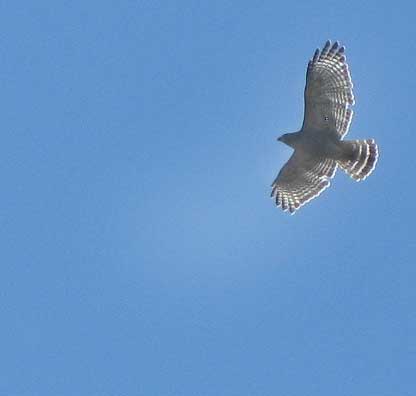Excerpts from Jim Conrad's
Naturalist Newsletter
from the February 16, 2014 Newsletter issued from the Frio Canyon Nature Education Center in the valley of the Dry Frio River in northern Uvalde County, southwestern Texas, on the southern border of the Edwards Plateau; elevation ~1750m (~5750 ft); N29.62°, W99.86°; USA
RED-SHOULDERED HAWK ON A POLE

In late afternoon I was lying in a large field of windblown King Ranch Bluestem when a broad-winged, short-tailed, buteo-type hawk came flying in a straight line low over the grass. He alighted on a nearby power pole, bent forward and began staring hard into the undulating grass below, searching for his usual prey of rodents, insects and small birds. That's our bird above.
It was a Red-shouldered Hawk, and in the picture you can see that not only is his shoulder a dark, rusty color, but also his head and chest. And the chest is horizontally barred, not vertically as with some other species.
Red-shouldered Hawks are mostly an eastern species, so we're at its western limit of distribution, except for a disjunct population in California. In the northernmost part of its distribution the birds are migratory, but here they stay year round.
from the September 29, 2013 Newsletter issued from the Frio Canyon Nature Education Center in the valley of the Dry Frio River in northern Uvalde County, southwestern Texas, on the southern border of the Edwards Plateau; elevation ~1750m (~5750 ft); N29.62°, W99.86°; USA
RED-SHOULDERED HAWK FROM BELOW
It's that time of year when hawks are wandering, showing up where they're not usually seen. Since my vision isn't so good I photograph any hawk that flies over, then look at it on the computer screen. One such picture is shown below:

Michael Overton's checklist "Birds of Uvalde County, Texas" lists 20 species of "Kites, Hawks, Eagles & Allies," and some of those don't turn up in most of the US, such as the Zone-tailed and Short-tailed Hawks and Common Black-Hawk. The one in our picture looked very familiar but without comparing field marks with those in the field guide I didn't want to make a snap judgment.
Several hawk species display banding similar to this hawk's. For example, the Short-tailed hawk's tail banding is similar, except that its two inner bands are narrower than the outer one, which isn't the case here. Also, the wings of Short-tails don't display nearly as many conspicuous narrow bands as appear on this one.
It turns out that the hawk in our picture was the common one around my hermit camp back in southwestern Mississippi, the Red-shouldered Hawk, BUTEO LINEATUS. One of the Red-shouldered Hawk's field marks consists of the "translucent windows" at the base of the wings' outermost primary feathers, and those windows show nicely in our photograph. When the sun isn't shining above the birds, the windows aren't as conspicuous.
Michael Overton lists Red-shouldered Hawks as uncommon at all seasons in Uvalde County, and it's true that the distribution map in my field guide shows that we're exactly on the Red-shouldered's westernmost point of distribution. Several hawk species occur coast-to-coast in North America, but Red-shouldered Hawks are mainly Eastern, with an isolated, or "disjunct," population in coastal California. I associate Red-shouldered Hawks with swamps and river floodplains with tall trees, none of which we have here at the edge of the Chihuahuan Desert. Our bird must have been feeling adventurous to penetrate this far into arid land.
from the January 12, 2003 Newsletter issued from the woods near Natchez, Mississippi, USA
RED-SHOULDERED HAWKS SCREAMING
This week's mostly warm, sunny days have been busy ones for the Red-shouldered hawks, BUTEO LINEATUS. Usually by midmorning the air had warmed nicely, a slight breeze had begun stirring, and a very great deal of hawk screeching began issuing from the sky.
Some mornings this week I planted apple trees, wearing nothing but a pair of shorts and sandals, and the sunlight, breezes and hawk calls overhead made a heady mixture as I worked. The male hawks were doing their best to impress the females, and it was easy to see that the females were often intrigued by what they saw. Often three or four birds flew tight circles near one another, sometimes almost touching in midair, all the while issuing their shrill calls. One call was a kind of "kee-yar," and another was a constantly repeated, sharp "eep, eep, eep."
The males swooped a lot. High in the sky a male would suddenly draw in his wings, dive headfirst, level out, then, as on a roller-coaster ride, shoot back skyward carried by his momentum, performing a U. I suppose that the tighter the U, the faster the dive, and the higher he climbed with his built-up momentum, the more impressed the female became.
The funniest thing was when a male rested at his perch and a female deigned to visit. The male often gave the clear impression of being surprised, even intimidated, by the visit. Especially the male's body language showed that he was of two minds. On the one hand he was desperately eager for the female's attention but, on the other, he was more than a little respectful of her powerful build and sharp beak and talons.
My books say that this sky-screaming takes place from courtship to the start of incubation. However, here I've heard them calling year round, though right now their calls are more noticeable than usual.